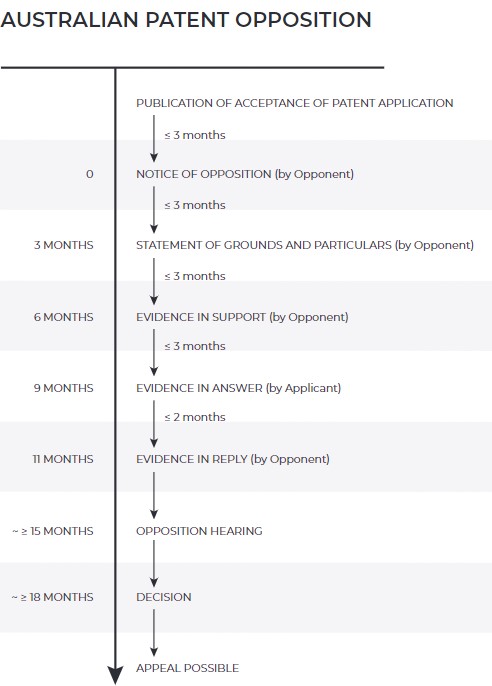
An explanation of these steps is below:
An Opposition to the grant of an Australian Patent may be filed by any party, to challenge it’s validity. Reasons for opposing the grant of an Australian Patent may include that the invention is not a patentable invention (e.g. not new and/or inventive), that the specification does not comply with the formal requirements of the Patents Act (e.g. that the claims lack clarity or support on the specification described), and/or, to contest the ownership of the invention. The following provides a brief outline of the process.
Notice of Opposition
A formal Notice of Opposition must be filed by the Opponent within three months of the date of publication of acceptance/allowance of the Patent Application by the Australian Patent Office.
Statement of Grounds and Particulars
Within 3 months of filing a Notice of Opposition, the Opponent must then file a Statement of Grounds and Particulars. The Statement of Grounds and Particulars must identify the relevant sections of the Australian Patents Act which the Opponent intends to rely on throughout the Opposition process, and, must incorporate enough detail to allow the Patent Applicant to understand the case to which they have to respond, and, should include details of any documents, other disclosures of the invention, etc., which the Opponent believes contests the patentability of the claims, etc.
Evidence in Support
Within 3 months from filing the Statement of Grounds and Particulars, the Opponent then submits their Evidence in Support of the Opposition. Evidence in Support of the Opposition typically incorporates comments from one or more expert in the field of the invention, prepared in the form of a Statutory Declaration or Affidavit, outlining their opinion, as a person skilled in the technical field of the invention, as to why they believe that the invention may not be new, inventive, or otherwise patentable, etc. in light of the disclosures of the documents identified in the Statement of Grounds and Particulars.
Evidence in Answer
The Patent Applicant then has a period of 3 months within which to file their Evidence in Answer. Evidence in Answer is typically also in the form of a Statutory Declaration or Affidavit made by one or more expert in the field of the invention, but, seeking to contest the grounds, particulars and evidence in support which has been filed by the Opponent.
Evidence in Reply
Finally, the Opponent has a period of 2 months within which to file any Evidence in Reply. Evidence in reply is typically limited to responding to the Patent Applicant’s Evidence in Answer, and again is typically in the form of a Statutory Declaration or Affidavit made by the Opponent’s expert.
Opposition Hearing
A Hearing will then be scheduled by the Australian Patent Office. The Hearing may be held orally and/or by written submissions, at which a Hearing Officer will consider this submissions made and the evidence received by both the Opponent and the Patent Applicant. The Australian Patent Office hearing process is a reasonably informal process, and each party (typically represented by their patent attorney) is given an opportunity to present and argue their case against the case of the other party.
Decision
A formal Decision and a statement of reasons is typically provided to both parties within a few months of the hearing. The Decision may conclude that the Opponent is entirely successful and that the patent application should therefore not progress to grant, or, that the Opponent is entirely unsuccessful and that the patent application should be granted in its present form. Otherwise, in the event that the Opponent is at least partly successful, the Patent Applicant may be given an opportunity to amend their patent specification to overcome any issues identified as problematic, so that the Patent Application can then progress to grant in a modified form.
Appeal
If either party disagrees with the Decision, an Appeal may be filed to the Federal Court of Australia.